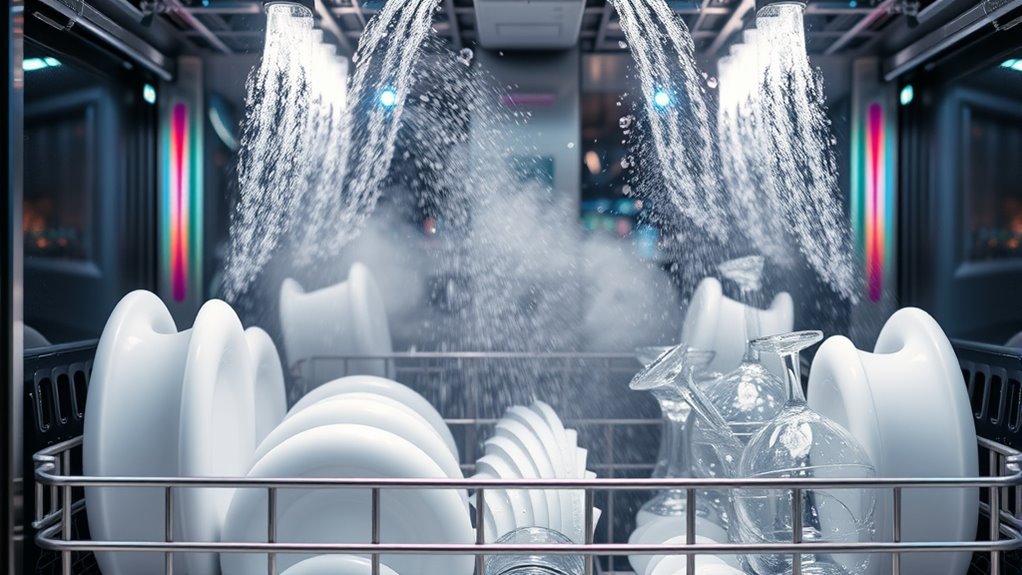Your dishwasher cleans dishes by using powerful water jets that spin inside and spray water at high pressure, loosening food and grease. Heated cycles help break down stubborn residues and sanitize, while specialized detergents emulsify fats for easy rinsing. Advanced sensors optimize water temperature, spray patterns, and cycle length based on how dirty your dishes are. If you want to learn how all these features work together for sparkling results, keep exploring how modern dishwashers operate.
Key Takeaways
- Water jets and spray arms spin to distribute high-pressure water, loosening and removing food particles and grease from dishes.
- Detergents with surfactants emulsify fats and dirt, turning residues into suspensions that are easily rinsed away.
- Heat speeds up grease breakdown, melts fats, and sanitizes dishes by killing bacteria.
- Sensors detect soil levels and adjust water pressure, temperature, and spray patterns for optimal cleaning.
- Effective cleaning results from a combination of proper water pressure, well-functioning spray arms, and tailored cycle settings.
The Role of Water Jets in Cleaning
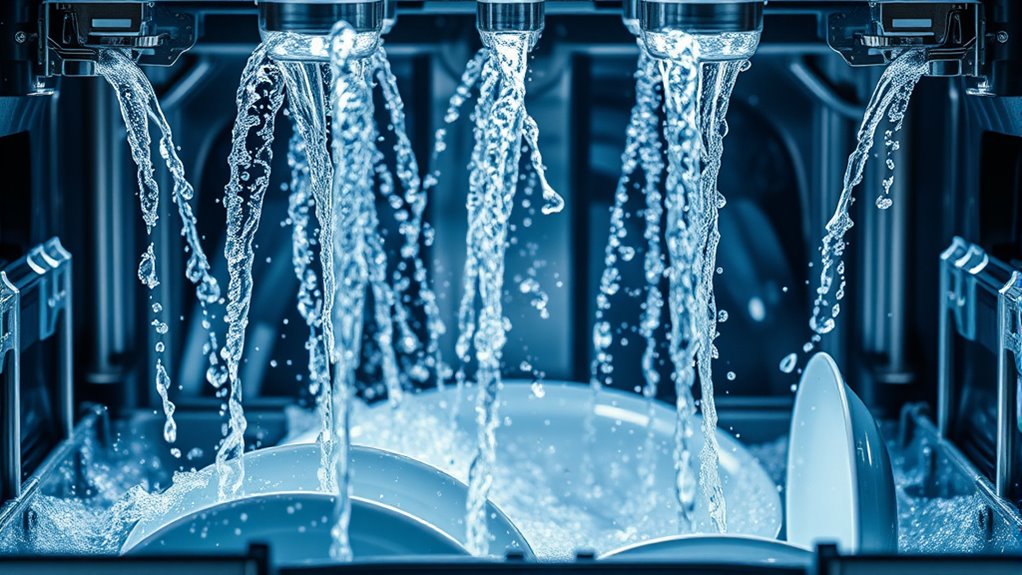
Have you ever wondered how a dishwasher manages to clean so effectively? It all comes down to the power of water jets. The spray arm, positioned inside the dishwasher, spins and sprays water at high pressure onto your dishes. This water pressure is essential because it helps loosen and remove food particles, grease, and grime. As the spray arm rotates, it distributes water evenly across all dishes, ensuring every surface gets covered. The design of the spray arm allows jets of water to shoot out in multiple directions, maximizing coverage. Without sufficient water pressure or a well-functioning spray arm, cleaning would be ineffective. Additionally, the water jet technology used in modern dishwashers ensures that water reaches every corner, making cleaning more thorough and efficient. So, the combination of powerful water jets and strategic spray arm movement is what makes your dishwasher so efficient at cleaning.
How Detergents Break Down Grease and Dirt
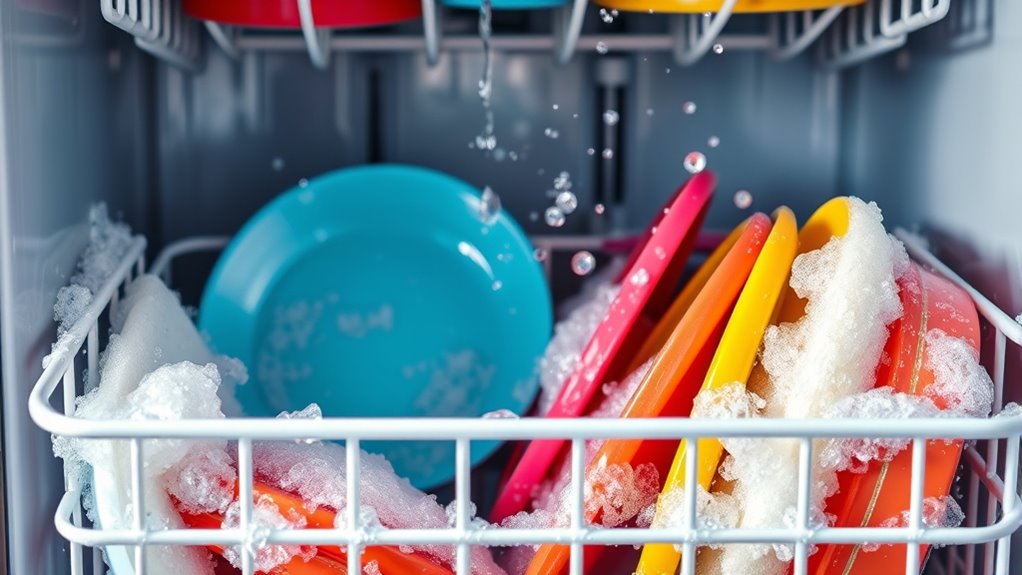
Once the powerful water jets have loosened food and grime, detergents step in to break down these stubborn residues. This process relies on detergent chemistry, where molecules are designed to target grease and dirt effectively. Detergents contain surfactants—special compounds that reduce surface tension between water and oily substances. These surfactants surround grease particles, forming tiny droplets that are easier to wash away. Their unique structure allows them to penetrate and emulsify stubborn fats, making grease breakdown possible. As a result, your dishwasher’s detergent transforms greasy, stubborn residues into manageable suspensions, ensuring they are rinsed away cleanly. Understanding detergent chemistry helps explain how these molecules work so efficiently to achieve spotless dishes without requiring manual scrubbing.
The Importance of Heat in the Washing Process
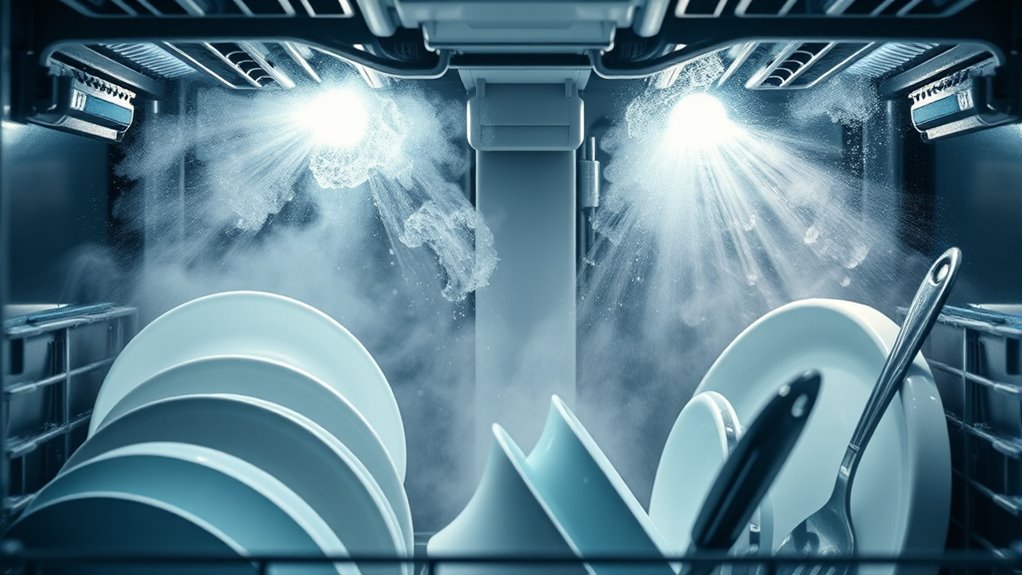
Why is heat so essential in the dishwasher’s cleaning process? Heat provides the thermal energy needed to enhance cleaning power. It accelerates the breakdown of grease and grime, making detergents more effective. Heat transfer quickly raises water temperature, ensuring dishes are sanitized and free of bacteria. The higher temperature loosens food particles and melts fats, helping water and detergent reach all surfaces. Without adequate heat, cleaning is less efficient, and bacteria may survive. Here’s a quick look at how heat transfer works:
| Heat Transfer Method | Effect on Cleaning |
|---|---|
| Conduction | Direct contact heats surfaces |
| Convection | Circulates hot water |
| Radiation | Not typically used in dishwashers |
| Conduction | Transfers heat from water to dishes |
| Convection | Distributes heat evenly |
This process ensures your dishes come out clean and sanitized.
The Washing Cycle: From Rinse to Dry
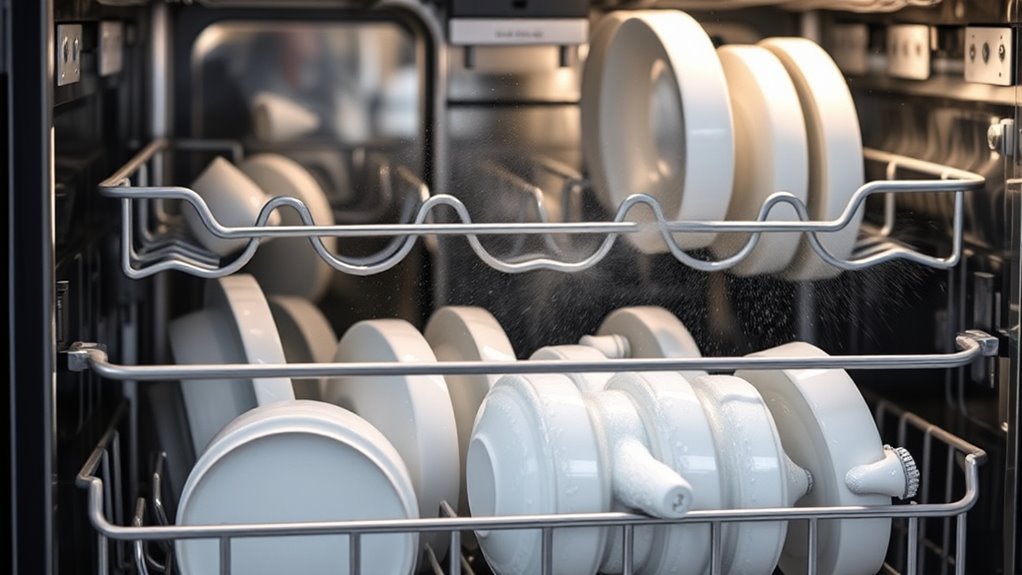
As your dishwasher moves through the cycle, it starts with rinsing and washing to remove food debris and grime. Then, it shifts to drying techniques that guarantee your dishes come out spotless and ready to use. Understanding these phases helps you optimize your dishwasher’s performance and get the best cleaning results.
Rinse and Wash Phases
The rinse and wash phases are the core of a dishwasher’s cleaning process, working together to remove food particles and grime from your dishes. During the wash cycle, you choose your detergent type—powder, gel, or pods—that dissolves in water to break down grease and residue. The rinse phase uses clean water to loosen remaining debris and prepare dishes for drying. Rinse aid plays an essential role here, helping water sheet off surfaces for streak-free results. The table below highlights key differences:
| Phase | Main Focus | Key Products |
|---|---|---|
| Rinse | Remove loose debris, prep for drying | Rinse aid, water |
| Wash | Break down grease and grime | Detergent (powder, gel, pods) |
| Both | Guarantee cleanliness and shine | Water temperature, rinse aid |
Together, these steps ensure your dishes come out spotless. Proper water temperature and detergent formulation are crucial for optimal cleaning performance.
Drying Techniques Used
After the rinse and wash phases finish, your dishes still need to dry properly to prevent water spots and streaks. Modern dishwashers often use energy efficient drying methods like heated dry cycles or fan-assisted drying, which save energy while ensuring dishes come out spotless. However, these cycles can still leave residual moisture, so manual drying techniques remain useful. You can use a clean microfiber cloth or a soft towel to quickly dry your dishes, especially for items prone to water spots. This approach reduces reliance on energy-intensive drying cycles and gives you more control over the drying process. Additionally, residual moisture can sometimes be trapped in hard-to-reach areas, making manual drying even more effective. Combining energy efficient drying with manual techniques helps you achieve sparkling dishes while conserving energy and preventing streaks.
Sensors and Technology Ensuring Spotless Results

Your dishwasher uses advanced sensors to optimize cleaning performance. It adjusts water temperature, detects soil levels, and modifies spray patterns to match the load. These technologies work together to guarantee your dishes come out spotless every time. Additionally, some models incorporate HEPA filtration or other air purification features to improve overall kitchen air quality during operation.
Water Temperature Control
Ever wondered how your dishwasher achieves those sparkling, spotless dishes every time? It’s all thanks to precise water temperature control. Modern dishwashers use sensors to monitor water temperature regulation, ensuring it stays at ideal levels for cleaning. Advanced thermal safety features prevent overheating, protecting both your dishes and the appliance. This technology guarantees the right heat for breaking down stubborn stains and sanitizing your dishes thoroughly. When the water reaches the perfect temperature, your dishwasher adjusts in real-time, saving energy and water. Temperature sensors play a crucial role in maintaining optimal conditions throughout the cycle. You can trust that every cycle delivers powerful cleaning without risking damage or safety hazards. The seamless coordination of sensors and safety features makes your dishwashing experience effortless, leaving you with spotless results every single time.
Soil Level Detection
Modern dishwashers leverage advanced soil level detection sensors to identify how dirty your dishes are during each cycle. These sensors use soil detection technology to assess the amount of grime and food residue on your load. Load sensing allows the dishwasher to determine the appropriate amount of water, detergent, and cycle duration needed for effective cleaning. When the sensors detect heavily soiled dishes, the system adjusts the cycle for more thorough washing. Conversely, if dishes are lightly soiled, the dishwasher conserves resources by reducing water and energy usage. This real-time feedback ensures peak cleaning performance while minimizing waste. Soil level detection not only guarantees spotless results but also enhances efficiency, making each wash tailored to your load’s specific needs. Additionally, incorporating beneficial ingredients like collagen and hyaluronic acid in eye patches can further improve skin hydration and nourishment.
Smart Spray Patterns
Smart spray patterns utilize advanced sensors and technology to target dirt precisely where it’s needed, ensuring thorough cleaning with less water and energy. By optimizing spray arm design and enabling cycle customization, your dishwasher adapts to different loads for maximum efficiency. These intelligent systems detect soil levels and adjust spray angles and pressure, reaching every corner of your dishes. This precise targeting means fewer missed spots and sparkling results every time. With smart spray patterns, you gain confidence knowing your dishwasher is working smarter, not harder. Experience peace of mind as your dishes come out spotless, thanks to innovative technology that personalizes each wash cycle. Understanding how these systems operate can help you make the most of your appliance’s capabilities. – Feel the satisfaction of perfectly clean dishes every time – Enjoy saving water and energy without sacrificing cleanliness – Trust in technology that adapts to your busy life
Common Features and Their Functions
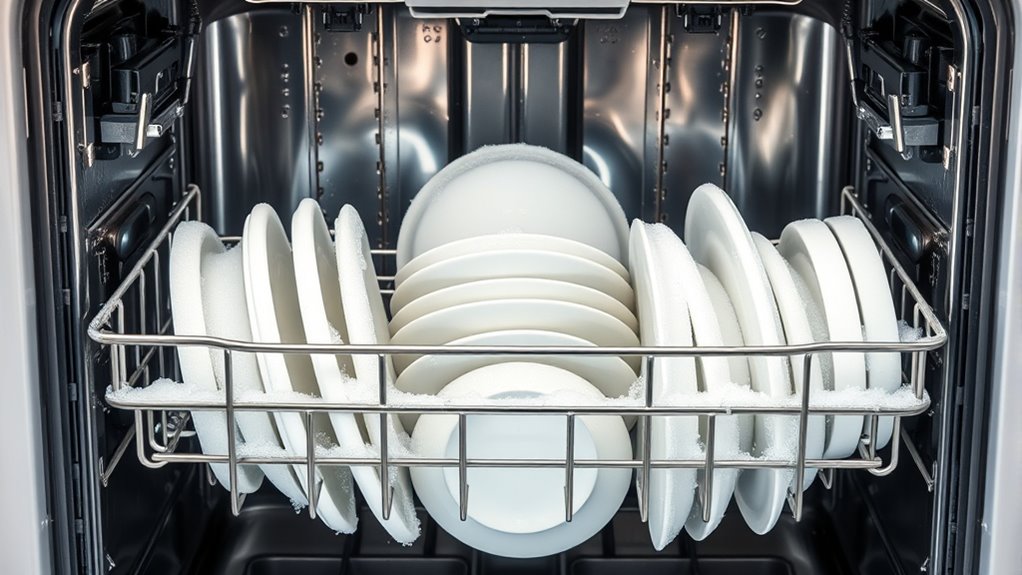
Understanding the common features of dishwashers can help you operate and maintain your appliance more effectively. Most dishwashers have a detergent dispenser designed for different detergent types, ensuring your dishes get cleaned with the right cleaning agents. Cycle customization allows you to select specific wash cycles based on your needs, whether for lightly soiled or heavily stained dishes. A heated dry option helps dishes dry faster, while sensors detect soil levels to adjust water and cycle duration automatically. Spray arms distribute water evenly, and filters trap debris to prevent clogs. Racks and adjustable tines accommodate various dish sizes and shapes. Familiarizing yourself with these features enables you to optimize performance, save energy, and keep your dishwasher running smoothly. Additionally, some modern dishwashers incorporate smarter features, such as Wi-Fi connectivity, to monitor and control the appliance remotely.
Tips for Maximizing Your Dishwasher’s Effectiveness
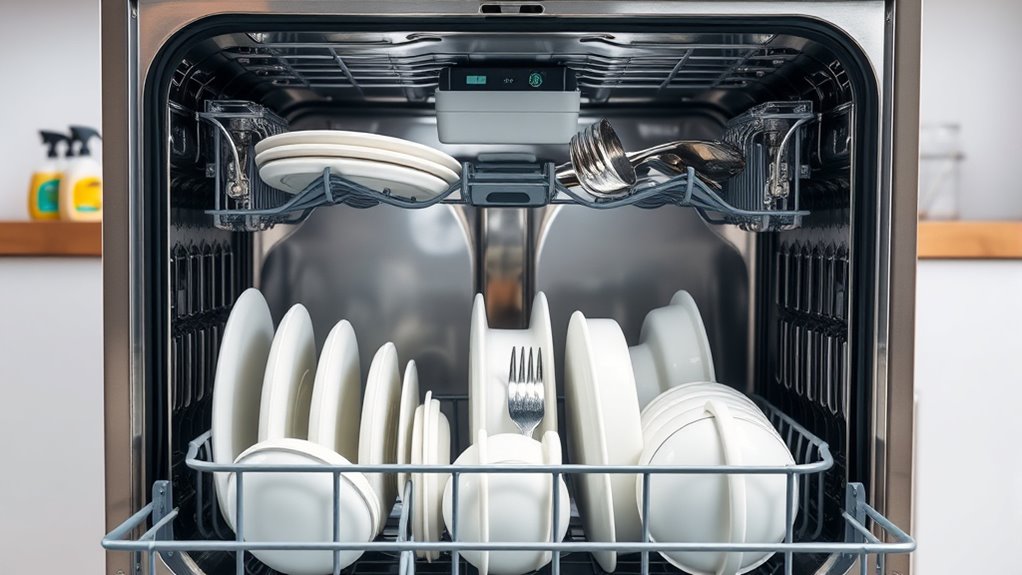
Maximizing your dishwasher’s effectiveness starts with proper loading techniques. Arrange dishes so water can reach every surface, avoiding overcrowding that hampers cleaning. Regular dishwasher maintenance, like cleaning filters and spray arms, guarantees ideal performance and longevity. Use eco-friendly cleaning solutions to reduce environmental impact without sacrificing cleanliness. To get the best results, follow these tips:
- Load dishes correctly, placing pots and pans face down for thorough cleaning
- Run full loads to maximize energy and water efficiency
- Use eco-friendly detergents for a greener, effective clean
- Also, consider dishwasher tuning options to optimize performance and efficiency.
These simple steps not only enhance your dishwasher’s performance but also promote sustainable practices. Taking care of your appliance through regular maintenance and eco-friendly cleaning helps keep dishes spotless while protecting the environment.
Frequently Asked Questions
How Do Dishwashers Prevent Dishes From Scratching During Cleaning?
You might wonder how dishwashers prevent dishes from scratching during cleaning. They use gentle wash cycles and specialized spray arms to minimize impact. Additionally, dishwasher noise reduction features help keep vibrations low, so dishes don’t bump into each other. Water temperature control also plays a role by ensuring the water isn’t too harsh, reducing the chance of scratches. Together, these elements protect your dishes and keep them looking new.
What Materials Are Best Suited for Dishwasher-Safe Dishes?
When choosing dishwasher-safe dishes, you want materials with good durability and heat resistance. Look for options like tempered glass, certain plastics labeled dishwasher-safe, stainless steel, and glazed ceramic. These materials withstand high temperatures and frequent washing without warping or cracking. Avoid delicate or porous materials like fine china or unglazed pottery, which may not endure the heat or vigorous cleaning processes. Selecting the right materials guarantees your dishes stay intact and clean after each cycle.
How Does the Dishwasher’s Filter Affect Cleaning Performance?
Your dishwasher filter plays a vital role in cleaning efficiency by trapping food particles and debris. When it’s clean, water flows freely, ensuring better dirt removal and spotless dishes. If you neglect to clean the filter regularly, it can become clogged, reducing performance and leaving residue on your dishes. So, make sure to check and clean your dishwasher filter often to keep your machine running at its best and dishes sparkling clean.
Can Dishwashers Remove All Types of Food Stains Completely?
Think of your dishwasher as a diligent worker, but even it can’t erase all food stains completely. While dishwasher capabilities excel at food stain removal, some stubborn or old stains, like wine or coffee, may linger. You might need pre-treatment or special cycles for tough spots. So, no, dishwashers can’t remove all food stains perfectly, but they do a great job handling most everyday messes.
How Often Should I Perform Maintenance to Keep My Dishwasher Optimal?
You should perform routine checks and follow a regular cleaning schedule to keep your dishwasher running smoothly. Aim to clean the filter and spray arms monthly, and run a cleaning cycle every one to three months with a dishwasher cleaner or vinegar. Regular maintenance prevents buildup, guarantees peak performance, and prolongs the appliance’s lifespan. Staying consistent with these tasks helps your dishwasher stay in top condition, providing spotless dishes every time.
Conclusion
Now that you know how your dishwasher works, you’re practically a cleaning wizard! With water jets, powerful detergents, heat, sensors, and smart features, it’s like having a tiny, unstoppable army fighting grime 24/7. Just follow the tips, and your dishes will sparkle brighter than a diamond in a fireworks show. Get ready to impress everyone with your spotless, gleaming dishes—your dishwasher’s secret powers are now in your hands!
